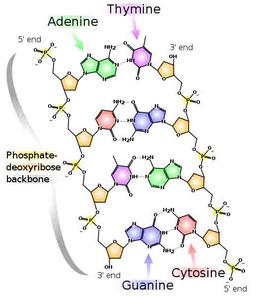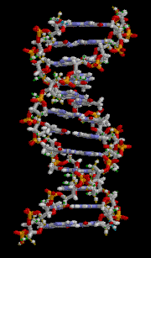 | ||||
What Are Nucleotides & Nucleic Acids? - P2
Page last updated:
4/2016
SPO VIRTUAL CLASSROOMS
PAGE 2 < Back to Page 1
What Is DNA?
There are four different types of nitrogenous bases that can be found in a DNA molecule:
- adenine (A)
- guanine (G)
- cytosine (C)
- thymine (T)
Adenine and guanine are larger, double ring nitrogenous bases called purines. Cytosine and thymine are smaller, single ring nitrogenous bases called pyrimidines.
When the DNA molecule is inactive, the bases are linked by these hydrogen bonds and the molecule is in its spiral-shaped state.
Nucleic Acid Structure
Nucleotides can be linked together by covalent bonds between the phosphate of one nucleotide and the sugar of next. These linked monomers become the phosphate-sugar backbone of nucleic acids. The nitrogenous bases extend out from this phosphate-sugar backbone like teeth of a comb.
When bases pair up between the two DNA strands, a purine always pairs with a pyrimidine. Specifically adenine (A) and thymine (T) pair up, and cytosine (C) and guanine (G) pair up. These bases are attracted to each other through hydrogen bonding.
When DNA is being used—either being copied (a process called
replication) or being employed to build proteins (involving the processes of transcription and translation)—the DNA molecule must be opened up, essentially “unzipped” between the bases.
VIDEO
DNA Structure & Replication
from
Crash Course Biology
 | ||||||
SPO is a FREE science education website. Donations are key in helping us provide this resource with fewer ads.
Please help!
(This donation link uses PayPal on a secure connection.)
You have FREE access to a large collection of materials used in a college-level introductory biology course. The Virtual Biology Classroom provides a wide range of free educational resources including PowerPoint Lectures, Study Guides, Review Questions & Practice Test Questions.




